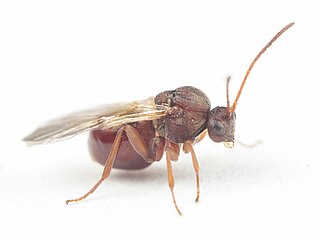
Diplolepis is a genus of approximately fifty species of gall-inducing wasps in the family Diplolepididae. The larvae induce galls on wild roses (Rosa), and rarely on domestic roses.

Gall wasps, also traditionally calledgallflies, are hymenopterans of the family Cynipidae in the wasp superfamily Cynipoidea. Their common name comes from the galls they induce on plants for larval development. About 1,300 species of this generally very small creature are known worldwide, with about 360 species of 36 different genera in Europe and some 800 species in North America.

The Cynipoidea are a moderate-sized hymenopteran superfamily that presently includes seven extant families and three extinct families, though others have been recognized in the past. The most familiar members of the group are phytophagous, especially as gall-formers, though the actual majority of included species are parasitoids or hyperparasitoids. They are typically glossy, dark, smooth wasps with somewhat compressed bodies and somewhat reduced wing venation. It is common for various metasomal segments to be fused in various ways, and the petiole is very short, when present.

Andricus is a genus of oak gall wasps in the family Cynipidae.

The Ibaliidae are a small family of the hymenopteran superfamily Cynipoidea. Ibaliidae differ from most of the cynipoids by the larvae being parasitoids on other wasp larvae in the group Siricidae. The Ibaliidae comprise three extant genera of fairly large wasps, with a total of 20 species, and is a sister group to the rest of the cynipoids except the small subfamily Austrocynipidae.

Andricus dentimitratus is a gall forming wasp in the genus Andricus. The adults lay their eggs on various species of oak and the developing larvae causes the trees to create a large ornate gall. The oaks parasitised include Quercus frainetto, Q. petraea, Q. pyrenaica, Q. pubescens and Q. robur. The gall is formed out of the cup of the acorn. In cross-section it resembles a mushroom. It is woody, maroon, shiny and sticky. It grows up to 25 mm high and 20 mm wide. What resembles the head of the mushroom is lobed or toothed in various ways. The insect emerges from the narrowing, between the head and base.

Cynipinae is a subfamily of gall wasps (Cynipidae). Many of the approximately 1,500 described species cause galls on oaks, but some induce galls on other plant species or are inquilines of the gall-inducing species. Species occur on all continents, except Antarctica, with most found in the temperate regions of the northern hemisphere. All extant cynipid species are within Cynipinae since the only other recognized subfamily is Hodiernocynipinae, which is based on the fossil genus Hodiernocynips.

Cynipini is a tribe of gall wasps. These insects induce galls in plants of the beech and oak family, Fagaceae. They are known commonly as the oak gall wasps. It is the largest cynipid tribe, with about 936 to 1000 recognized species, most of which are associated with oaks. The tribe is mainly native to the Holarctic.

Bassettia is a genus of gall wasps found in North America.
Synergini is a tribe of gall wasps in the subfamily Cynipinae.

Amphibolips is an American genus of gall wasps in the family Cynipidae. There are about 57 described species in the genus Amphibolips with several others still undescribed.

Feron kingi, the red cone gall wasp, is a species of gall wasp in the family Cynipidae.

Heteroecus is a genus of gall wasps in the family Cynipidae. There are about seven described species in the genus Heteroecus.

Diastrophus is a genus of gall wasps in the family Cynipidae. There are at least 21 described species in Diastrophus.

Disholcaspis is a genus of gall wasps in the family Cynipidae. There are more than 40 species described in the genus Disholcaspis. Some Disholcaspis species induce galls that produce honeydew, a sweet liquid that attracts yellow jackets, ants, and bees. These insects then protect the galls from parasitic wasps.

Liposthenes glechomae is a species of gall wasp in the family Cynipidae. It is found in Europe and Northern Asia as well as North America where it and its host plant Glechoma hederacea are invasive, non-native species. Galls may appear as small red blemishes on foliage and develop into large green galls nearly as long as one of the plant's leaves.

Callirhytis is a genus of gall wasps in the family Cynipidae. There are more than 90 described species in Callirhytis. Wasps in this genus primarily induce wasps on oak trees in North America.

Phylloteras is a North American genus of gall wasps in the family Cynipidae, tribe Cynipini .

Kokkocynips is an American genus of gall wasps in the family Cynipidae. There are about 8 described species in the genus Kokkocynips with several others still undescribed.

Ceroptres is a genus of gall wasp. Most of its species are found in North America, and most are inquilines, meaning it oviposits its eggs in a host gall. These host galls are mostly induced by other gall wasps, but some species of Ceroptres use the galls of gall midges.

















